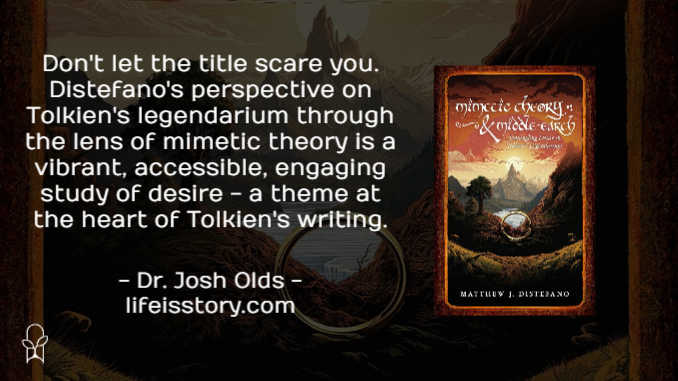
Published by Quoir on March 14, 2024
Genres: Non-Fiction
Buy on Amazon
Goodreads

Mimetic Theory & Middle-earth: Untangling Desire in Tolkien's Legendarium, by long-time author Matthew J. Distefano, delves deeply into J.R.R. Tolkien's Middle-earth, using René Girard's mimetic theory as the primary lens through which to view the good professor’s legendary texts. Exploring the influence of imitative desire on iconic heroes such as Frodo Baggins, Samwise Gamgee, and the wizard Gandalf, as well as infamous villains like Melkor, Sauron, and Saruman, this timely philosophical follow-up enriches our understanding of both literature and the human condition by shedding light on the connections between imitation, rivalry, and transcendence, ultimately leaving readers with a sense of hope, rather than despair.
Mimetic Theoy and Middle-earth. Don’t let the title scare you, Matthew Distefano’s perspective on JRR Tolkien’s legendarium through the lens of mimetic theory isn’t some academic text about some obscure philosophy. Instead—read the subtitle—this is an accessible, easily-understandable foray into Tolkien’s views on the concept of desire. Desire, particularly for power, is at the heart of the world Tolkien created.
From the very beginning, Melkor (who would become known as Morgoth), desires the power of Eru, the One. Later, Morgoth desires the Silmarils created by Fëanor and that story is what comprises much of The Silmarillion. Sauron, a lieutenant of Morgoth, become the Dark Lord in Morgoth’s place and his own desire for power—a different type of power than Morgoth—becomes wrapped up in the One Ring, which then exerts its influence of desire upon any who are near it. But desire isn’t inherently negative. The tale of Beren and Luthien—modeled on Tolkien’s real-life romance with his wife—is about the desire of love. Bilbo’s desire to live simply as a Hobbit is quite commendable (in fact, see Distefano’s other Tolkien book The Wisdom of Hobbits) for that. Gandalf’s desire to free Middle-earth from Sauron’s influence is likewise a positive thing.
But maybe I’m getting ahead of myself. What is mimetic theory? Mimetic Theory and Middle-earth explains the concept in the first chapter in full, with helpful diagrams and everything, but I’ll summarize it here with one sentence from the theory’s originator, Rene Girard: “We desire what others desire because we imitate their desires.” That imitation is mimesis (to mimic). Our desires are influenced—for good and ill—by others. It is from this that rivalries are born and rivalries soon create enemies. The solution to rivalrous mimetic desire is the collaboration of friendship.
Distefano then moves into three pillars of culture and their impact on desire: prohibition, ritual, and myth. In terms of prohibition, he used The Fall of Númenor as his basis in Tolkien to show how the Valar’s preventing the Numenorians from going to the Undying Lands actually intensified their desire for immortality. Ritual gets play in both a positive and negative sense. Of particular note is Distefano’s point that non-sacrificial rituals are part of what makes us truly human. Rituals build community and commonality; it is a binding force that draws people together. Myth, then, becomes a particular culture’s way of telling that story.
From here, Mimetic Theory and Middle-earth talks about the role of the scapegoat in mimetic theory before turning to a specific discussion of the One Ring, the greatest object of desire in Tolkien’s universe. The final part deals with positive mimesis as a counter to negative mimesis, focusing particularly on the values of friendship and loyalty seen throughout Tolkien’s writing.
It’s really quite surprising how comprehensive Distefano manages to be. So many books on Tolkien’s writings focus on The Lord of the Rings and The Hobbit exclusively. Either that is the only content the authors think their audiences will relate to, or perhaps it’s the only content with which the author is familiar. Distefano shows incredible range and a vast knowledge of the scope of Tolkien’s legendarium, referencing not only the stories of The Silmarillion, but even parts of History of Middle-earth and other more obscure texts—the Numenorians, for instance, getting a lot of discussion with Distefano showing a good working knowledge of The Fall of Numenor. At the same time, Mimetic Theory and Middle-earth is still accessible to the casual Tolkien fan who has not read beyond Tolkien’s most popular works. Distefano writes about the less-known content in a way that readers can still follow while hopefully being driven to read those other works for context.
Tolkien studies are booming and it’s amazing that something relatively novel and original can be written out of Tolkien’s work. A lot of Tolkien books I read rehash a lot of the same themes in mostly the same way. Mimetic Theory and Middle-earth offers something new and fresh, a critical analysis of desire that honors Tolkien and his writing by taking it seriously and truly understanding his work. The Professor would be pleased.
